| Pages:
1
2 |
Nikotin
Harmless

Posts: 11
Registered: 20-5-2023
Location: Eu
Member Is Offline
Mood: Blessed
|
|
Weird things during nitric acid synthesis
Hi, this is my first time posting here, not sure if this is the correct location.
Anyways, today I synthesized nitric acid from potassium nitrate and sulfuric acid.
This is my third time doing this, but the first time with a setup this "elaborate".
But weird things happened.
So the first pic shows my setup, so you have a clue what was going on.
The second picture shows the product, but for some reason two layers formed and both seem to be nitric acid. At the beginning there was just one layer
but at some time the liquid stopped coming, so I thought it was done. But later, it started coming over again, bubbling into the "gas catcher" far
more than the first time. This time whatever came over seem to be immiscible. I am not sure what this is or why it didn't want to mix really. I
thought maybe it's just nitric acid with a lower concentration and therefor different density, but maybe someone here knows better. Maybe something
bubbled over while I wasn't paying attention, seems to be unlikely tho. Also unlikely that the sulfuric acid got to boiling as my thermometer showed
never more than 120°C, but the round bottom flask itself got up to 150°C at least, according to my laser thermometer.
After stirring it seems to have mixed, but I am unsure if it will separate later again maybe.
But this is not the one weird thing that happened, as my "gas catcher" water beaker absorbed the NO2, it turned into nitric acid of course. I tested
the water even with a PH-Strip and it's at 1 or less. But weirdly my very dilute nitric acid it this catcher turned out blue? Does anyone have an idea
why this could be? Only thing I can think of is the test strip somehow turning it a very light blue, even though it turned red with the acid.
As I am fairly new I just thought I may ask you guys, thank you already!
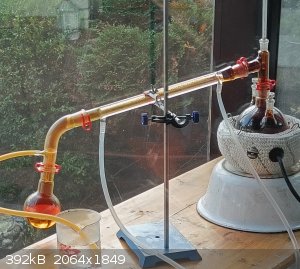 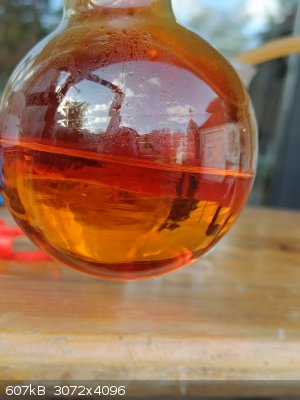 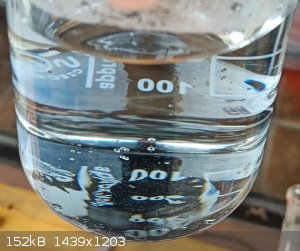
[Edited on 30-10-2023 by Nikotin]
[Edited on 30-10-2023 by Nikotin]
|
|
|
B(a)P
International Hazard
    
Posts: 1117
Registered: 29-9-2019
Member Is Offline
Mood: Festive
|
|
Hi Nikotin and welcome to the forum!
What was the concentration of your sulfuric acid when you started?
Is there any chance your reaction mix foamed over and entered the receiver?
I think you are right about the two different acid densities. It could be that you have near pure nitric acid on the bottom and red fuming on the top.
You may have pushed the reaction too far and had decomposition of the nitric acid, which would give you a lower density and darker red coloured acid
coming over. This would also account for the additional gas noted toward the end. If this is the case you will not get separate layers again now they
have mixed. Have they remained separate?
For the beaker, did it turn blue when you put in the test strip? A better practice is to extract a little liquid then drip it on the test paper. If
not any chance you had copper or some other metal contamination in the beaker?
|
|
|
Nikotin
Harmless

Posts: 11
Registered: 20-5-2023
Location: Eu
Member Is Offline
Mood: Blessed
|
|
First and foremost, thanks already for the fast answer.
According to the manufacturer it's 96%, but it's drain cleaner, so I am not 100% sure.
Yeah, it at one point foamed but i stopped it at the last second, maybe a few drops got over but all the Potassium salt stopped in the condenser
before it could make it over. (this was fairly early)
As sulfuric acid is more dense it would be very weird if it would float on top and I saw that the drops that came over later penetrated thru the top
layer into the bottom layer, when they came down they slowly floated to the top and mixed with the top layer.
If it is separate now, i do not know, as I put it into a brown glass bottle, but I will take a look tomorrow. I also thought that maybe some water got
sucked in, I hear that other people had that happen with a similar setup, at most it should have been a few drops again.
I measured the density of it after i mixed it and it was almost exactly 15g at 10ml. which would mean a concentration of ~94%.
About the blue color, I only noticed it after the test strip, so it's very possible that it came from that. Thanks for the advice, next time i will
just drop some on it and not put the strip into the liquid.
Copper contamination seems unlikely, as I haven't worked with copper yet, but some of the glassware is used, so it isn't impossible. But as I clean my
glassware pretty well and have used it several times for different things since I purchased it, it seems fairly unlikely.
But I realized that the color might also be from the hose/tube I used, as the gases really took their toll on it and made it brittle.
[Edited on 30-10-2023 by Nikotin]
[Edited on 30-10-2023 by Nikotin]
|
|
|
Sir_Gawain
Hazard to Others
  
Posts: 272
Registered: 12-10-2022
Location: Due South of Due West
Member Is Offline
Mood: Yes.
|
|
You might have heated it enough to drive some water out of the sulfuric acid. Also, 10 mL is not nearly large enough of a sample to get good density
measurements. Try dripping some onto a nitrile glove. If it quickly bursts into flames, it's probably over 90%.
“Alchemy is trying to turn things yellow; chemistry is trying to avoid things turning yellow.” -Tom deP.
|
|
|
Admagistr
Hazard to Others
  
Posts: 350
Registered: 4-11-2021
Location: Central Europe
Member Is Offline
Mood: The dreaming alchemist
|
|
The colour is indeed indicative of the decomposition of HNO3 and the formation of NO2.I suspect that concentrated H2SO4 got into the HNO3 and
decomposed it.You used technical utility H2SO4 and there is probably a problem here, unless the cause is an inconspicuous splash of H2SO4 into the
flask with the product.It would be useful to find out what impurities and components your H2SO4 contains and whether it is usable for this particular
reaction because of its content.Does the manufacturer give the complete chemical composition of the cleaner?
|
|
|
Nikotin
Harmless

Posts: 11
Registered: 20-5-2023
Location: Eu
Member Is Offline
Mood: Blessed
|
|
Thanks for the message, I will test the density tomorrow at 50ml, results may differ due to me having to use a less accurate scale for that and as I
mixed it with a little nitric acid that was already in the bottle. I will also drip some on a nitrile glove.
|
|
|
Nikotin
Harmless

Posts: 11
Registered: 20-5-2023
Location: Eu
Member Is Offline
Mood: Blessed
|
|
Quote: Originally posted by Admagistr  | | It would be useful to find out what impurities and components your H2SO4 contains and whether it is usable for this particular reaction because of its
content.Does the manufacturer give the complete chemical composition of the cleaner? |
The source of the acid is "Normatek Hydraulik" drain cleaner, there is some polish datasheet but I can't find it right now, as I am not polish.
I am sure it contains sulfuric acid and the datasheet says 96%. The color is clear, that is all I know from the top of my head.
Edit: found it: https://te-ch.pl/pl/p/file/4c609b5f34b064dc62f371dfe369e0cb/...
Also I used it before and had no problems, I will do more research tomorrow, as it's pretty late.
Thank you guys!
[Edited on 30-10-2023 by Nikotin]
|
|
|
Sir_Gawain
Hazard to Others
  
Posts: 272
Registered: 12-10-2022
Location: Due South of Due West
Member Is Offline
Mood: Yes.
|
|
150°C is far too hot for fuming nitric acid. Nitric acid decomposes into NO2 and water upon excessive heating. Judging by the extremely
dark color in the flask, I think that's very likely. The blue color of the gas trap water could also be from dissolved NO2 or nitrous acid.
“Alchemy is trying to turn things yellow; chemistry is trying to avoid things turning yellow.” -Tom deP.
|
|
|
Keras
National Hazard
   
Posts: 775
Registered: 20-8-2018
Location: (48, 2)
Member Is Offline
|
|
IMHO, using impure sulphuric acid to make nitric acid is not a good idea. The nitric acid will probably react with whatever additives are present in
the drain cleaner and form a slew of compounds, some of which will pass with the nitric acid and stain your final product. Given than nitrous products
have a knack for explosions, especially when heated, I would be very careful here and use only pure stuff. Distill your drain cleaner before using it.
That being said, the brown colour is pretty normal. It’s damn hard to get colourless nitric acid right from the distillation apparatus. The best way
to do it is to bubble nitrogen or argon into your fuming nitric acid until all the NO₂ has been carried away.
|
|
|
woelen
Super Administrator
        
Posts: 7977
Registered: 20-8-2005
Location: Netherlands
Member Is Offline
Mood: interested
|
|
The blue color in the water trap most lkely is due to formation of N2O3. This stuff can exist in dilute acidic aqueous solution for quite some time.
I have observed this blue color many times, when working with NOx fumes. Easiest way to observe it is dissolving some nitrite in water and then adding
excess dilute acid, but you can also see it, when you dissolve NOx-fumes in water. The water turns blue, due to formation of HNO2, which in turn is in
equilibrium with N2O3.
If you allow this to stand for a day, then the blue color should have disappeared though. N2O3 finally ends up as NO and HNO3 in water and if air is
present, then it all will end up as HNO3.
If the blue color indeed persists after a day or so, then it must be some contamination, probably from the test strip.
|
|
|
Sulaiman
International Hazard
    
Posts: 3561
Registered: 8-2-2015
Location: 3rd rock from the sun
Member Is Offline
|
|
When using cheap (drain unblocker) sulphuric acid with nitrate salts to make nitric acid,
I use excess sulphuric acid (especially with calcium nitrate) to reduce hot-spots that decompose nitric acid.
If stoichiometric ratios of acid and nitrate are used then the sulphate produced makes even heating difficult.
I've read that (but not tried) using hydrogen peroxide in the gas trap will produce nitric acid directly.
CAUTION : Hobby Chemist, not Professional or even Amateur
|
|
|
Nikotin
Harmless

Posts: 11
Registered: 20-5-2023
Location: Eu
Member Is Offline
Mood: Blessed
|
|
Quote: Originally posted by Sulaiman  |
I use excess sulphuric acid (especially with calcium nitrate) to reduce hot-spots that decompose nitric acid. |
Same, I used 400g of Potassium Nitrate and 250g of Sulfuric acid.
Also:
I tested the density again today and it came out at 94% again, 75g at 50ml, see picture.
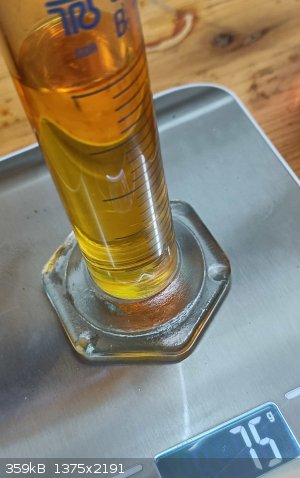
I also looked at the acid and it didn't seem to separate, but that was in the brown bottle, so I put it in a beaker and waited for half an hour, as I
didn't have more time to wait, but it didn't separate.
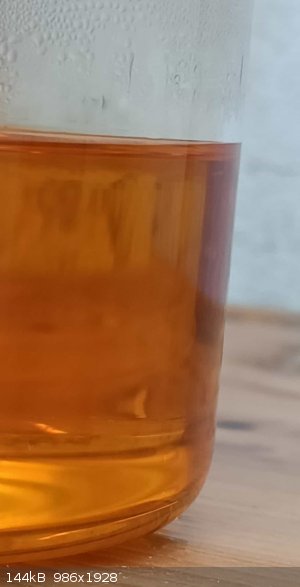
I also put about 2ml on a nitrile glove and it started fuming instantly and caught fire within like 5 sec.
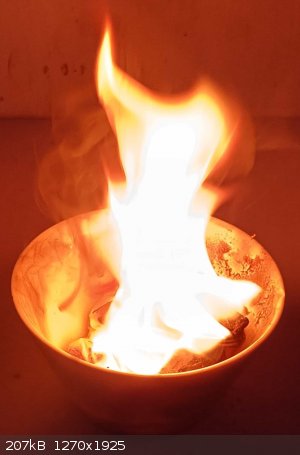
[Edited on 1-11-2023 by Nikotin]
|
|
|
B(a)P
International Hazard
    
Posts: 1117
Registered: 29-9-2019
Member Is Offline
Mood: Festive
|
|
Nice work, looks like you have a good product, so long as the dissolved nitrogen oxide is ok for your purposes. How did the beaker of water turn out,
has it lost its colour? I had no idea you could have a dilute solution of N2O3 in water such that you would actually see the blue colour. Very
interesting.
|
|
|
Nikotin
Harmless

Posts: 11
Registered: 20-5-2023
Location: Eu
Member Is Offline
Mood: Blessed
|
|
Sadly I did not keep the water, sorry.
If it happens again I will post it here. 
Thank you all very much btw!
[Edited on 31-10-2023 by Nikotin]
|
|
|
Sir_Gawain
Hazard to Others
  
Posts: 272
Registered: 12-10-2022
Location: Due South of Due West
Member Is Offline
Mood: Yes.
|
|
To up the purity and remove most of the NO2, re-distill it with some sulfuric acid. Just make sure to heat very carefully and make sure
your cooling water is ice cold.
“Alchemy is trying to turn things yellow; chemistry is trying to avoid things turning yellow.” -Tom deP.
|
|
|
Nikotin
Harmless

Posts: 11
Registered: 20-5-2023
Location: Eu
Member Is Offline
Mood: Blessed
|
|
Thanks for the advice Gawain, I have not heard of this method so far, but I am willing to try it.
But are you sure that the 4% Water in the sulfuric acid will not make the product worse, or do you think the acid is hygroscopic enough to pull more
water out actually?
|
|
|
Rainwater
National Hazard
   
Posts: 800
Registered: 22-12-2021
Member Is Offline
Mood: indisposition to activity
|
|
You can use a dehydrating agent to remove more water from your nitric acid.
H2SO4 is a great choise as it loves water
Use of an excess will trap water while allowing you to distill a more pure nitric acid.
Useing the H2SO4 boiling point chart (found here) you can see that 96% sulfuric acid has a much higher boiling point than nitric acid(78c)
By knowing the amount of water in your nitric and the different boiling points, you can crudely determine the amount of sulfuric acid needed to
completely dry your product.
Calculate the weight of the water you wish to remove, and add enough sulfuric acid to ensire that its boiling point remains above 120c
According to the chart Wiki provided, thats about a 50% (125c) consentration of H2SO4
Havent had my coffee yet, this math isblikly to be wrong
Nitric at 94%
Sulfuric at 96%
Amount to dilute sulfuric acid to 96-50=46%
Amount of water per gram of nitric 100-94=6
weight ratio 6/46=0.13
So add at least 0.13g of sulfuric acid to every gram of your nitric and distill.
The fraction that comes over at 78-79c will be anhydrous nitric acid.
Anything after that will have water in it.
Stop collection after 120c.
See here for a professional amateur
https://m.youtube.com/watch?v=88gbfCnrV8o
Edit. The 78c is wrong. I was thinging ethonol. Mitric acid will be different
[Edited on 1-11-2023 by Rainwater]
"You can't do that" - challenge accepted
|
|
|
Sir_Gawain
Hazard to Others
  
Posts: 272
Registered: 12-10-2022
Location: Due South of Due West
Member Is Offline
Mood: Yes.
|
|
Pure nitric acid boils at 83°C, 68% azeotropic at 120°C.
If you want to purify your sulfuric acid to 98% and get rid of any organic contaminants, add a few mL of hydrogen peroxide and heat it to 330°C. I
also use drain cleaner, and after concentrating it I achieved 98-99% nitric acid with one distillation.
“Alchemy is trying to turn things yellow; chemistry is trying to avoid things turning yellow.” -Tom deP.
|
|
|
Nikotin
Harmless

Posts: 11
Registered: 20-5-2023
Location: Eu
Member Is Offline
Mood: Blessed
|
|
Can you really purify sulfuric acid by adding hydrogen peroxide? If so what concentration of hydrogen peroxide is needed to do so?
About what Rainwater said, couldn't I use a big excess of Sulfuric acid with 50%? I have way to much of 50% sulfuric acid anyways.
[Edited on 1-11-2023 by Nikotin]
|
|
|
Sir_Gawain
Hazard to Others
  
Posts: 272
Registered: 12-10-2022
Location: Due South of Due West
Member Is Offline
Mood: Yes.
|
|
1. Yes, hot sulfuric acid plus hydrogen peroxide will destroy any organic contaminants like the dyes and inhibitors in drain cleaner. Heating sulfuric
acid to about 330°C will drive off water until it's about 98% pure; this will also work for 50% sulfuric acid. Do it outside as it releases a large
amount of sulfuric acid vapor. Here's a video about it.
2. Rainwater mentioned 50% because that's the minimum concentration of sulfuric acid that won't distill over with the nitric acid. You should use the
most concentrated sulfuric acid you have. Adding about half the amount of sulfuric acid to nitric should work. Make sure not to heat far past the
boiling point of pure nitric acid or it will decompose.
“Alchemy is trying to turn things yellow; chemistry is trying to avoid things turning yellow.” -Tom deP.
|
|
|
Nikotin
Harmless

Posts: 11
Registered: 20-5-2023
Location: Eu
Member Is Offline
Mood: Blessed
|
|
I have distilled sulfuric acid before, albeit with mediocre success, from about 50 to 85%, as I ran out of time. I have a lot of 50% acid, so I will
most definitely try it again.
I would think that it will be better now, as I have a better setup and am a bit more experienced.
Only hydrogen peroxide is one thing I don't have, as regulation is a small hell. Max is 12% as you probably already know.
The concentrated acid I already have is already at 96% and is clear and has no smell, so I don't really think that I have to clean it up for anything
I use it for. It seems to be only acid with water and nothing else, I can't be 100% sure tho of course. If I ever come across worse drain cleaner I
will use your mentioned method.
Let's see how it will work out next time and thank you very much <3
|
|
|
Rainwater
National Hazard
   
Posts: 800
Registered: 22-12-2021
Member Is Offline
Mood: indisposition to activity
|
|
The beautiful thing about sulfuric acid, other than how when heated will instantly destroy your flesh on contact, it that is 99% recyclable.
Within reason, the consentration of the sulfuric acid doesnt matter, the more consentrated it is, the less you need.
You can always boil the water out if it to bring the consentration back up.
Just remember safty first.
These are powerful things to work with.
Treat them like they can kill you.
Adding H2O2 to the sulfuric acid will accelerate a lot of reactions, turning carbon contamination into co2 that bubbles out, but so will nitrate
salts.
I have used some perty nasty looking sulfuric acid for the production of HNO3, it was never an issue.
Fyi, the byproduct, potassium bisulfate is very useful.
1kg properly neturalized is enough to fertilize about 1 acre of farm land for a year.
The pyrolysis of this reagent results in a compound that will being iridium into solution.
"You can't do that" - challenge accepted
|
|
|
Nikotin
Harmless

Posts: 11
Registered: 20-5-2023
Location: Eu
Member Is Offline
Mood: Blessed
|
|
Hey, thanks for the advice but I have 2 questions.
Quote: Originally posted by Rainwater  |
Fyi, the byproduct, potassium bisulfate is very useful.
1kg properly neturalized is enough to fertilize about 1 acre of farm land for a year.
|
Isn't potassium sulfate the main product, and isn't it also a good fertilizer? Also how do I separate the potassium sulfate from the bisulfate? The
last few times it was a solid chunk at the bottom of my flask and the only way to get it out without destroying my glassware was washing it out with a
lot of water, so I would have to boil the water away or leave it outside in hot weather for a few days maybe to get rid of the water, if I removed it
from the flask like that.
And I did not at all understand what you tried to tell me with that sentence, but maybe I am just stupid, so can you explain maybe, because it sounds
interesting?
|
|
|
Rainwater
National Hazard
   
Posts: 800
Registered: 22-12-2021
Member Is Offline
Mood: indisposition to activity
|
|
Pyrolysis- heating while protecting from air.
Causes the compound to decomose into other things.
https://www.sciencemadness.org/smwiki/index.php/Potassium_bi...
Iridium is one of the most corrosion-resistant metals known. Immune to aqua rega and hydrofluoric acid, and temperatures over 2000c, this metal is
difficult to bring into a chemical reaction.
Its basicly the badass of the chemical resistance literature
"You can't do that" - challenge accepted
|
|
|
Rainwater
National Hazard
   
Posts: 800
Registered: 22-12-2021
Member Is Offline
Mood: indisposition to activity
|
|
| Quote: | | Also how do I separate the potassium sulfate from the bisulfate? |
I havent tried that before.
it should be possible through recrystallization or extraction, lets search the wiki
With water
The sulfate salt has a solubility between 20 and 100c of 111g-240g
The bisulfate salt has a solubility between 20 and 100c of 49g-121g.
So thats no good. Requires a lot of math and precision
But looky here, sulfate is insoluble in liquor and the bisulfate is..
It could be used as an extraction solvent.
But thats a waste of good drink.
"You can't do that" - challenge accepted
|
|
|
| Pages:
1
2 |